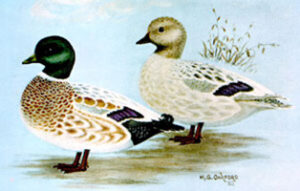This article on the Snowy Call Duck is being republished from Acorn Hollow Bantams website with permission from Lou Horton.
There exists about as much confusion and frustration among breeders and exhibitors regarding the proper coloration of the Snowy Call as there is with any color pattern in the Calls. Serious common color flaws exist in both sexes.
The main problem in male plumage color is that one almost never sees a male with ideal color. Either the flanks are too dark with little or no lacing (most common) or there is no claret color on the flanks at all. The speculum is frequently faded or it is made up of fewer secondaries than it should, leading to a speculum which is not as prominent as it should be. When one also considers that the tendency to oversize and other Call body type flaws in the males, it becomes very difficult to find a male that meets all the necessary criteria. To make matters worse, while the written descriptions of the breast and flank color of the male are similar in both the ABA and APA Standards, the APA illustration does not do justice to the written description and the ABA has dropped an illustration of the Snowy altogether in its most recent edition. That is especially unfortunate given the fact that earlier editions of the ABA Standard contained a painting in full color of both sexes donated by Graham Oakford which properly illustrates the plumage color, particularly the breast (bib) color of the male. Oakford knew a little bit about the Snowy color pattern given the fact that he developed them and introduced them.
The female Snowy color pattern is complete with subtle stippling and lacing in the breast, flank, back and head areas. The single most common plumage color problem with the female is body sections which are either lacking in color (almost white) or too strongly colored. It is important that those areas of subtle color be complimented with strong color in the wing speculum. Unfortunately, that area has not been one of emphasis in many strains and the speculum in both sexes is often weakly colored and/or smaller (does not contain the full 11 colored secondary feathers) than it should be.

Other common color problems in the female include head color which is not the delicately stippled fawn color (being either grayish or dark brown), primary feathers which are either all white or solid colored instead of the ashy brown with white edges which are specified. Bill color in the female should be dark orange with a darker saddle but is sometimes lead colored.
From the above, one could correctly surmise that the Snowy female plumage pattern is complex and that putting all of those elements together in one bird can drive a breeder crazy. It should be noted that even though he worked on the color pattern for two decades or more, Graham Oakford never felt that he raised even one bird of either sex that put all aspects of ideal plumage color together perfectly. When one adds the requirements involved in ideal type and size, one can get an idea of the challenges that not only breeders but judges face when working with the Snowy.
For those Snowy call duck breeders who would like a copy of the Oakford painting, you can locate a copy of the 1983 ABA Standard which contains a ½ page version.
By Lou Horton
